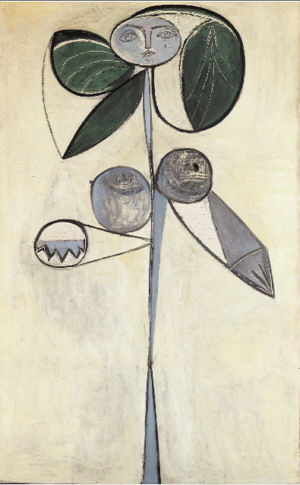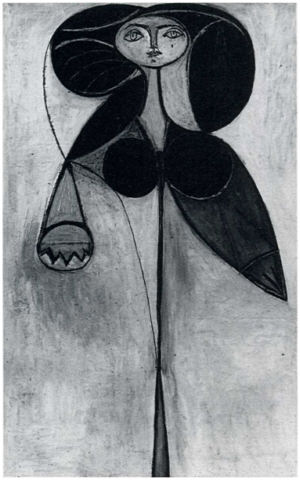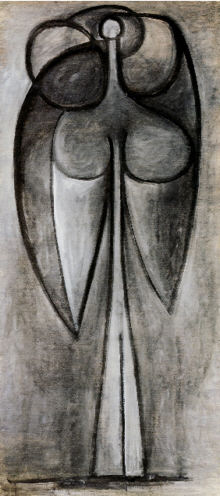
Even if you don’t care greatly about Picasso, I recommend the Charlie Rose interview with Françoise Gilot, who lived ten years with the man. A talented artist herself, and very independent-minded, Gilot frequently discussed art with Picasso. Much of what he said about how he worked has come to us through her. For example, regarding the rather complex, high cubist paintings, he said than in the “early stages” there were almost no “references to natural forms…I painted them in afterwards.” Braque had a similar working procedure. Rather than abstract from an initial representation of a scene, these cubists–at least for a time as their approach evolved–roughly laid out their abstract, faceted spaces and forms, then filled in enough clues to suggest the subject. Those clues could appear in rather disconnected spots. I believe it was the dealer Kahnweiler who said they had developed a way to free objects, showing that they existed without showing where they were located.

Picasso was first introduced to Gilot in 1943, when he begged an introduction from an actor friend, who was sitting nearby at a restaurant with Gilot and another painter. I’ve seen it told several places that Picasso approached their table carrying a bowl of cherries, but Gilot mentions that he also left with them! After they began living together in 1946, Picasso painted a series of portraits of Gilot entitled Femme-fleur (loosely, Flower woman), shown here in order. With their hair transformed into a leaf canopy, they have an intriguing relationship to a well-known 1948 Robert Capa photo of the two at the beach.


Elsewhere on the Picasso front, I’ve started listening to TJ Clark’s Mellon Lectures as podcast from the National Gallery of Art (thanks to Namaste Nancy for the reminder). He’s a wonderful and detailed reader of paintings. But in an odd moment near the beginning, he appeared needlessly and overly scornful of those interested in the artist’s biography. No doubt, in the case of Picasso, there’s much third-hand gossip, and I suspect a good deal of what’s been written about his life would be worth reading. Nevertheless, he’s a fascinating and powerful character, fun to learn about even if I didn’t feel I was gaining some insight into his art.
I see the importance of being able to deal with an artwork in its own terms. But it seems not only limiting, but self-deceptive to claim that external knowledge is irrelevant. (I hasten to say that Clark himself does not make such an extreme claim, though he appears to have some distaste for personal history, despite frequently citing Gilot as a source.) Could we learn from art anything about ourselves, others, and the world, if those things were not involved in the work?
Do you have an interest in the personal histories of artists you care about? Or do you prefer to experience the art from a more “purist” perspective?

Lately, I have been thinking about the guru of my teenage years – Simone de Beauvoir.
She published her ‘Le Deuxième Sexe’ in 1949. Thus, she wrote her feminist book in the same decade in which Picasso reduced his significant other to a pair of mammary glands.
Picasso was not ahead of his time socially, and he certainly treated Gilot badly on occasion. Later, she apparently had a much more compatible marriage with Jonas Salk, living only a few miles from where I lived and worked for a number of years.
Steve:
Anon is the loneliest nombre that you’ll ever do. With apologies…
Personal history adds insight and spice. When is knowing an artist as a person a negative?
Not sure I ever liked Picasso… I think he had a very strong personality and his energy is reflected in the artworks. He was very talented and you can see it in his sketches, some fabulous drawings.
I heard his black eyes were fulminating and penetrating that would make anyone tremble.
Angela,
I have never liked Picasso’s paintings (a few drawings, yes) and I doubt I would like him personally–though I’m sure I’d find him very engaging to spend time with. However, I am intrigued by his work (especially the cubist elements), and I’m especially fascinated by what he thought–and others have said and written about–regarding space and perception and representation.